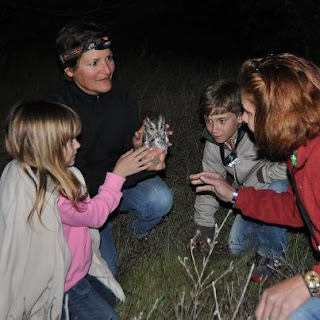Last post I questioned if owl captures could be related to moon phase. Literature from back east where the majority of owls are says yes, they are.
 |
| Web photo, Northern Saw-whet Owl and the Moon |
Theory has it that if the moon is bright, the small owls may not be as active because they may become prey instead of predator. Big owls, like the Great Horned will predate the Saw-whet. Where Barred Owls are present, netters have quite a challenge keeping them away from nets set during Saw-whet monitoring - the Barreds react to the Saw-whet call as though it were a dinner bell. Fortunately at our current sites we don't have to worry about Barred Owls-yet!
Another theory is that the owls can see the net array when the moon is bright. Indeed we can sometimes walk to the nets and not even need headlamps, so we figure if we can see the nets shimmering under moonlight, then certainly the nocturnal eye can.
Because our owl captures are relatively low (a small sample size) during the Snow Goose Festival, I graphed the outcome, owl captures vs. moon phase.
Here's what that looks like (two of the data-points are missing the moon phase graphic-but you get the picture). The graph shows the number of owls captured on the primary Y axis (left), the % moon phase on the secondary Y axis (right side) and the date of capture on the X axis. You can see during the brightest moon we do catch fewer Saw-whets, by one per/effort. On our last night in 2013, we caught a Western Screech Owl at BCEP, and a Saw-whet at BCCER, so only one owl per site. Interestingly two of our three owl captures on full moon nights were Western Screech Owls. Using this small data set, we would have a higher likelihood of capturing any Saw-whets in the area during Snow Goose Festival on a no moon night. That makes sense with the given theories.












